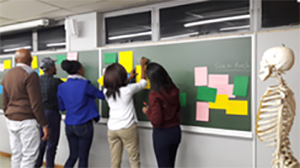
When I started lecturing full-time a little over five years ago, I knew what everybody does: that we all learn better by doing. I knew that “active learning” – literally doing anything apart from just talking through a PowerPoint presentation – is the way to go.
I’d also been introduced to the “flipped classroom” concept, an idea that has taken North America and Western Europe by storm. The flipped classroom means turning traditional teaching upside down. Instead of introducing concepts in class, then sending students off to do homework, you make them do some online work first (introducing themselves to the basic concepts) and use class time to tackle complex questions, working in small groups.
Despite this knowledge, I started off lecturing the way I was taught. I was the traditional “sage on the stage” presenting PowerPoint lectures to students silently taking notes.
Neither I nor my third-year students in a Marine and Freshwater Ecology course speak English as a first language. This added a layer of difficulty to understanding complex scientific concepts. And, top it off, I was teaching this course in a rural South African area called Qwaqwa – quite a distance from the nearest ocean.
After a year of teaching, I put my trepidation aside and tried a partially flipped classroom, hoping to boost my students’ learning and experiences. The results, documented in an article for the Journal for New Generation Sciences, have been extremely encouraging.
Taking a different approach
The “flipped classroom” approach is less common in Africa; my research turned up almost nothing.
There are probably several reasons for the slow uptake. Academics on this continent don’t often have access to the technology to create videos for students. Our students are not technologically savvy and nor are many of their lecturers. Students have come largely from poor educational backgrounds and are used to a particular way of learning. Adapting may be tough.
Using technology in science, technology and engineering and maths (STEM) education is a popular and effective way of boosting learning. But the vital aspect of a flipped classroom is combining technology with collaboration. Yes, students use technology to become familiar with complex concepts. True understanding, though, comes through interaction with each other and with the lecturer in the classroom. This is what gives them the real engagement with theories and ideas that can’t be shown in a laboratory or static textbook.

Collaborative problem-solving can get quite active in Qwaqwa’s classrooms.
I decided not to flip my entire course. Instead, I kept using PowerPoints for much of the 6-month long semester but picked a few key concepts I’ve seen students struggle to understand. These concepts became the focus of my flip.
I either found or created videos that students had to watch before class, making sure they did this by posting easy quizzes on Blackboard; an online platform on which course material, videos, quizzes, and so forth can be placed). In class, about 30 minutes of lecturing time were given over to worksheets that required a collaborative “think-pair-share” approach.
A question was posed that each student had to think about individually, and answer. They paired up to discuss their answers. Then they were asked a second question – closely related to the first – which they had to consider alone again. This ensures that students can mentally “translate” the recent discussion into their own words, in the same way they would have to answer questions during an exam.

An example of the first question in a think-pair-share activity.
Marrying technology and collaboration
Students loved the partial flip. They talked more and asked more questions in class; they requested more videos and more Blackboard quizzes. Their marks suggested that the videos helped: those that did watch the videos beforehand had significantly higher marks in the initial question during think-pair-share exercises.
The sharing – talking with a friend, in one’s mother tongue – made an even more profound difference. On this rural campus, with faulty internet and often disinterested students, I found that students really engaged with complex ecological material. Even more remarkable is that they could understand concepts like the Coriolis effect and rocky shore zonation patterns without having seen the ocean.
One student, giving anonymous feedback at the end of the semester, wrote:
I think much better than before …
Since that initial experiment, I’ve started using partial flips in all my courses. I honestly don’t think I ever want to do a fully-fledged flipped classroom, as just a week of Internet issues or power cuts – sadly common in rural areas in South Africa and elsewhere on the continent – could potentially ruin an entire module.
But a partial flip is possible. It’s easy to find video material on key challenging concepts related to any scientific discipline, so academics don’t have to record all their lectures exhaustively. I highly recommend it, and challenge other academics to try this approach, too.
Author Bio: Aliza le Roux is a Senior Lecturer at the University of the Free State
